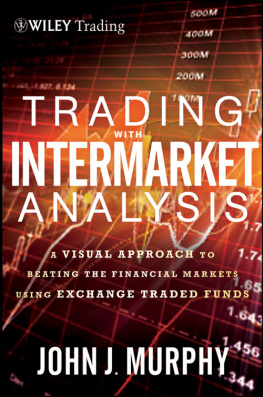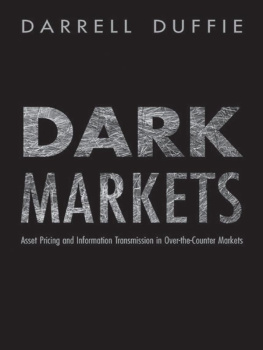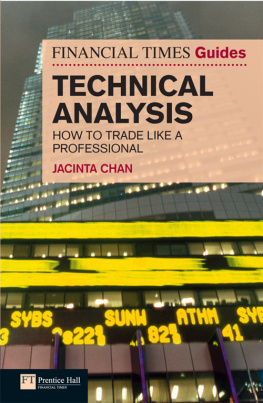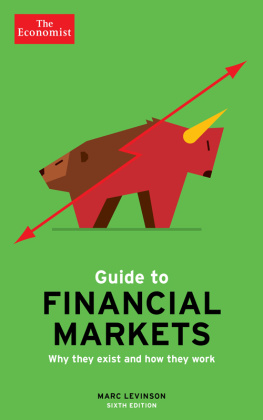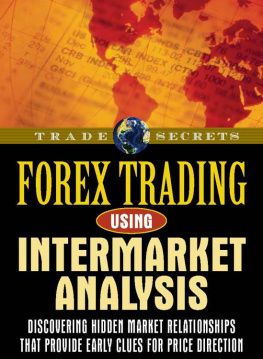P ANIC , P ROSPERITY , AND
P ROGRESS
Founded in 1807, John Wiley & Sons is the oldest independent publishing company in the United States. With offices in North America, Europe, Australia, and Asia, Wiley is globally committed to developing and marketing print and electronic products and services for our customers' professional and personal knowledge and understanding.
The Wiley Trading series features books by traders who have survived the market's ever changing temperament and have prosperedsome by reinventing systems, others by getting back to basics. Whether a novice trader, professional, or somewhere in-between, these books will provide the advice and strategies needed to prosper today and well into the future.
For more on this series, visit our website at www.WileyTrading.com .
P ANIC ,
P ROSPERITY , AND
P ROGRESS
Five Centuries of History and
the Markets
Timothy Knight

Cover Design: Wiley
Cover Illustration: top: gettyimages.com/Robin Bartholick; background: gettyimages.com/Keystone-France; bottom: gettyimages.com/DEA/A. Dagli Orti
Copyright 2014 by Timothy Knight. All rights reserved.
Published by John Wiley & Sons, Inc., Hoboken, New Jersey.
Published simultaneously in Canada.
No part of this publication may be reproduced, stored in a retrieval system, or transmitted in any form or by any means, electronic, mechanical, photocopying, recording, scanning, or otherwise, except as permitted under Section 107 or 108 of the 1976 United States Copyright Act, without either the prior written permission of the Publisher, or authorization through payment of the appropriate per-copy fee to the Copyright Clearance Center, Inc., 222 Rosewood Drive, Danvers, MA 01923, (978) 750-8400, fax (978) 646-8600, or on the Web at www.copyright.com . Requests to the Publisher for permission should be addressed to the Permissions Department, John Wiley & Sons, Inc., 111 River Street, Hoboken, NJ 07030, (201) 748-6011, fax (201) 748-6008, or online at www.wiley.com/go/permissions .
Limit of Liability/Disclaimer of Warranty: While the publisher and author have used their best efforts in preparing this book, they make no representations or warranties with respect to the accuracy or completeness of the contents of this book and specifically disclaim any implied warranties of merchantability or fitness for a particular purpose. No warranty may be created or extended by sales representatives or written sales materials. The advice and strategies contained herein may not be suitable for your situation. You should consult with a professional where appropriate. Neither the publisher nor author shall be liable for any loss of profit or any other commercial damages, including but not limited to special, incidental, consequential, or other damages.
For general information on our other products and services or for technical support, please contact our Customer Care Department within the United States at (800) 762-2974, outside the United States at (317) 572-3993, or fax (317) 572-4002.
Wiley publishes in a variety of print and electronic formats and by print-on-demand. Some material included with standard print versions of this book may not be included in e-books or in print-on-demand. If this book refers to media such as a CD or DVD that is not included in the version you purchased, you may download this material at http://booksupport.wiley.com . For more information about Wiley products, visit www.wiley.com .
ISBN 9781118684320 (Hardcover)
ISBN 9781118746172 (ePDF)
ISBN 9781118746110 (ePub)
This book is dedicated to Lee Barba, a fellow historian
and student of the markets. Thank you for taking the risk
that others lacked the courage to take.
PREFACE
A s I suspect the case is with many others, my interest in history did not reveal itself until long after my formal education was complete. A schools offering of dates, places, and long-forgotten names captures the interest of very few children, and unfortunately it usually snuffs out any latent desire they might have to explore tales of the past that can offer up wisdom, insight, and previously unseen linkages.
For most of my adult life, I have had a deep and abiding interest in two related subject areas: history and financial markets. While the two might seem to be only obliquely related, they are actually engaged in a constant dance, with one informing the actions of the other. Historical events move currencies, stocks, debt, and all other flavors of fiscal instrument, and likewise movementsparticularly exaggerated movementsin the financial markets can drive the decisions that shape history in real time.
When I first developed the outline of this book, I tried to gather up what I suspected were the most interesting and market-moving developments of the modern age. To my surprise, some of the events that I thought would have a major impact (such as the Kennedy assassination in 1963 or the London subway bombing of 2005) were, as far as financial markets were concerned, virtually immaterial; it was if they had never even happened. However, other topics I had initially left out, such as the Russian debt crisis of 1998, turned out to be monumentally important.
The completed book you are holding contains two dozen chapters of what I consider the most interesting and important episodes over five centuries that have had an impact on the thinking and behavior of financial markets. There are manias, panics, battles with inflation, the travails of war, and stories of riches both won and lost. The tales extend from early seventeenth-century Holland up to the twenty-first-century United States.
My hope is that, having read these accounts, the reader can gain perspectivespecifically, perspective of how consistent human behavior has been over the centuries, and how in spite of extraordinary technological, political, and legal changes, the templates that govern humanitys relationship with both opportunity and fear are surprisingly steady.
There will undoubtedly be new chapters in your own lifetime of globally important events that move both markets and sentiment. In the end, I hope the reader can be better armed to comprehend the worlds complexities and changes by way of the knowledge and insights this book endeavors to provide.
Tim Knight
Palo Alto, California
August 1, 2013
CHAPTER 1
Tulip Madness
I n popular culture, there is probably no better-known event in the lexicon of unusual financial history than the tulipmania that seized Holland in the early seventeenth century. Whenever there is a financial bubble in modern times, the term tulipmania is bandied about, but few commentators who use the term have a grasp as to what actual events occurred.
It is a fascinating taleperhaps somewhat apocryphaland, if nothing else, entertaining. And it is surely the only chapter in this compendium of financial history that involves not one but two important biological maladies that shaped the story: a flower-distorting virus and a deadly human plague.
An Introduction to the Flower in Question
If youve ever grown tulips, you know all too well that, while beautiful, the tulip is a temperamental and relatively weak plant whose bloom is short-lived and whose likelihood of returning the next year is far from certain.
The flower itself was unknown to most of Europe in the sixteenth century, but around 1554, the Popes ambassador to the Sultan of Turkey was charmed by the flower and collected seeds and bulbs for distribution. (The word tulip itself is said to be derived from the Turkish word for turban, since the bloom somewhat resembles the same).



